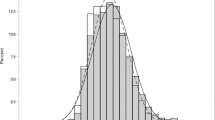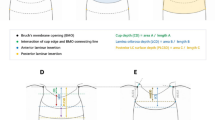Abstract
Background
To evaluate the risk of AAC and intraocular pressure (IOP) changes in diabetic patients after pupil dilation.
Methods
This cross-sectional study enrolled 2,287 diabetic patients among community residents in Guangzhou, China. All participants underwent routine pupil dilation unless they had a history of glaucoma. IOP was measured using a non-contact tonometer before and one hour after pupil dilation with tropicamide 0.5% and phenylephrine 0.5% eye drop. The proportion of AAC and changes in IOP after pupil dilation were evaluated.
Results
Only one of the 2,287 participants (0.04%) with diabetes developed post-dilation AAC. The mean pre and post-dilation IOP in the right was 16.1 ± 2.7 and 16.5 ± 2.8 mmHg (P < 0.001); mean pre and post-dilation IOP in the left was 16.5 ± 2.7 and 16.8 ± 2.8 mmHg (P < 0.001). Sixty-one participants (2.7%) showed an increase in IOP ≥ 5 mmHg and 25 participants (1.1%) showed a post-dilation IOP > 25 mmHg, including 11 participants (0.5%) who had both an increase in IOP ≥ 5 mmHg and post-dilation IOP > 25 mmHg. Lower pre-dilation IOP (OR = 0.827; 95% CI, 0.742–0.922; P = 0.001) and shallower anterior chamber depth (ACD) (OR = 0.226; 95% CI, 0.088–0.585; P = 0.002) were significant risk factors for an increase in IOP ≥ 5 mmHg in multivariate logistic regression analysis.
Conclusions
The risk of developing AAC after pupil dilation in diabetic patients was very low. Lower pre-dilation IOP and shallower ACD are risk factors for increased post-dilation IOP.
This is a preview of subscription content, access via your institution
Access options
Subscribe to this journal
Receive 18 print issues and online access
$259.00 per year
only $14.39 per issue
Buy this article
- Purchase on Springer Link
- Instant access to full article PDF
Prices may be subject to local taxes which are calculated during checkout

Similar content being viewed by others
Data availability
Data are available upon reasonable request.
References
Ting DS, Cheung GC, Wong TY. Diabetic retinopathy: global prevalence, major risk factors, screening practices and public health challenges: a review. Clin Exp Ophthalmol. 2016;44:260–77.
Klein R, Klein BE, Neider MW, Hubbard LD, Meuer SM, Brothers RJ. Diabetic retinopathy as detected using ophthalmoscopy, a nonmydriatic camera and a standard fundus camera. Ophthalmology 1985;92:485–91.
Tan CETBES Patterns of medical care for diabetics in the san francisco bay area. atlanta: centers for disease control. Diabetes Care. 1999.
Shaw BR, Lewis RA. Intraocular pressure elevation after pupillary dilation in open angle glaucoma. Arch Ophthalmol (1960). 1986;104:1185.
Hancox J, Murdoch I, Parmar D. Changes in intraocular pressure following diagnostic mydriasis with cyclopentolate 1%. Eye (Lond). 2002;16:562–6.
Harris LS. Cycloplegic-induced intraocular pressure elevations a study of normal and open-angle glaucomatous eyes. Arch Ophthalmol. 1968;79:242–6.
Yip JLY, Foster PJ. Ethnic differences in primary angle-closure glaucoma. Curr opin Ophthalmol. 2006;17:175–80.
Foster PJ, Johnson GJ. Glaucoma in China: how big is the problem? Br J Ophthalmol. 2001;85:1277–82.
Saw SM, Wong TY, Ting S, Foong AW, Foster PJ. The relationship between anterior chamber depth and the presence of diabetes in the Tanjong Pagar Survey. Am J Ophthalmol. 2007;144:325–6.
Patel KH, Javitt JC, Tielsch JM, Street DA, Katz J, Quigley HA, et al. Incidence of acute angle-closure glaucoma after pharmacologic mydriasis. Am J Ophthalmol. 1995;120:709–17.
Liew G, Mitchell P, Wang JJ, Wong TY. Fundoscopy: to dilate or not to dilate? BMJ 2006;332:3.
Wolfs RC, Grobbee DE, Hofman A, de Jong PT. Risk of acute angle-closure glaucoma after diagnostic mydriasis in nonselected subjects: the Rotterdam Study. Invest Ophthalmol Vis Sci. 1997;38:2683–7.
Tan GS, Wong CY, Wong TY, Govindasamy CV, Wong ZY, Yeo LY, et al. Is routine pupil dilation safe among asian patients with diabetes? Invest Ophthalmol Vis Sci. 2009;50:4110–3.
Lavanya R, Baskaran M, Kumar RS, Wong HT, Chew PT, Foster PJ, et al. Risk of acute angle closure and changes in intraocular pressure after pupillary dilation in asian subjects with narrow angles. Ophthalmology 2012;119:474–80.
Zhang Y, Niu M, Li Y, Wang J, Qu B, Zheng CX, et al. Prevalence and risk factors of diabetic retinopathy in hospital patients. Zhonghua Yi Xue Za Zhi. 2018;98:440–4.
Saeedi P, Petersohn I, Salpea P, Malanda B, Karuranga S, Unwin N, et al. Global and regional diabetes prevalence estimates for 2019 and projections for 2030 and 2045: Results from the International Diabetes Federation Diabetes Atlas, 9th edition. Diabetes res Clin Pr. 2019;157:107843.
Chiang YP, Bassi LJ, Javitt JC. Federal budgetary costs of blindness. Milbank Q 1992;70:319–40.
Flaxel CJ, Adelman RA, Bailey ST, Fawzi A, Lim JI, Vemulakonda GA, et al. Diabetic Retinopathy Preferred Practice Pattern(R). Ophthalmology 2020;127:P66–P145.
Lagan MA, O’Gallagher MK, Johnston SE, Hart PM. Angle closure glaucoma in the Northern Ireland Diabetic Retinopathy Screening Programme. Eye (Lond). 2016;30:1091–3.
Cabrera JV, Mozos PE, Sanchez JG, Rodriguez FB. Changes in intraocular pressure due to cycloplegia. Clao J. 1998;24:111–4.
Wiederholt M, Thieme H, Stumpff F. The regulation of trabecular meshwork and ciliary muscle contractility. Prog Retin Eye Res. 2000;19:271–95.
Yamada R, Hirose F, Matsuki T, Kameda T, Kurimoto Y. Comparison of mydriatic provocative and dark room prone provocative tests for anterior chamber angle configuration. J Glaucoma. 2016;25:482–6.
Ko Y, Kuo C, Kuang T, Chen W, Chou P, Liu CJ. Determinants of post-mydriatic intraocular pressure in phakic eyes with prevalent angle closure diseases. Graefe’s Arch Clin Exp Ophthalmol. 2021;259:137–43.
Zhao M, Sun Q, Oatts J, Hu GY, Ge L, Zhu BJ, et al. Changes in intraocular pressure and angle structure after dilation in primary angle-closure suspects with visually significant cataract. Ophthalmology 2021;128:39–47.
George R, Paul PG, Baskaran M, Ramesh SV, Raju P, Arvind H, et al. Ocular biometry in occludable angles and angle closure glaucoma: a population based survey. Br J Ophthalmol. 2003;87:399–402.
Sihota R, Lakshmaiah NC, Agarwal HC, Pandey RM, Titiyal JS. Ocular parameters in the subgroups of angle closure glaucoma. Clin Exp Ophthalmol. 2000;28:253–8.
Foster PJ, Johnson GJ. Glaucoma in China: how big is the problem? Br J Ophthalmol. 2001;85:1277–82.
Acknowledgements
This study was completed using data from the Guangzhou Diabetic Eye Study. This study is a cohort study of patients with diabetes in the community, Guangzhou. Thanks very much to all the Department of Preventive Ophthalmology staff and participants in this study.
Funding
This study was supported by the National Natural Science Foundation of China (82000901), the Fundamental Research Funds of the State Key Laboratory of Ophthalmology (303060202400362). The funding organizations had no role in the design or conduct of the study.
Author information
Authors and Affiliations
Contributions
Conception and design: WH, KX, WL, LW, and JH. Administrative support: WH. Provision of study materials or patients: WH. Collection and assembly of data: KX, WW. Manuscript writing: All authors. Final approval of manuscript: All authors.
Corresponding authors
Ethics declarations
Competing interests
All authors declare no competing interests.
Additional information
Publisher’s note Springer Nature remains neutral with regard to jurisdictional claims in published maps and institutional affiliations.
Rights and permissions
Springer Nature or its licensor holds exclusive rights to this article under a publishing agreement with the author(s) or other rightsholder(s); author self-archiving of the accepted manuscript version of this article is solely governed by the terms of such publishing agreement and applicable law.
About this article
Cite this article
Xiong, K., Wang, L., Li, W. et al. Risk of acute angle-closure and changes in intraocular pressure after pupillary dilation in patients with diabetes. Eye 37, 1646–1651 (2023). https://doi.org/10.1038/s41433-022-02215-y
Received:
Revised:
Accepted:
Published:
Issue Date:
DOI: https://doi.org/10.1038/s41433-022-02215-y
This article is cited by
-
A comprehensive review of artificial intelligence models for screening major retinal diseases
Artificial Intelligence Review (2024)



